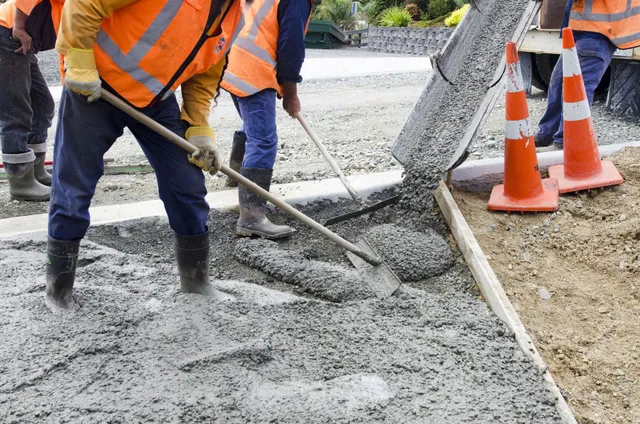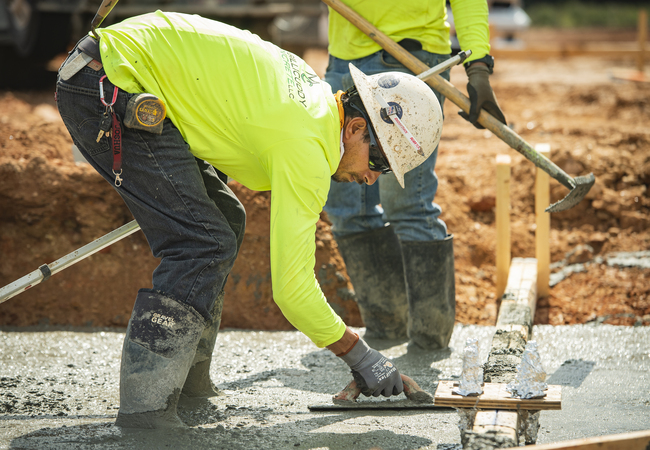Finishing Concrete Crew Mesquite TX is a crucial step in the construction process, as it determines the final appearance, texture, and durability of the concrete structure. Concrete crews employ various techniques to achieve smooth, uniform, and visually appealing finishes that meet project specifications and client expectations.

Here are some common techniques used by concrete crews for finishing concrete surfaces:
- Screeding:
- Screeding is the process of leveling and smoothing the surface of freshly poured concrete using a straightedge or screed board. Crew members guide the screed board along the top edges of the formwork to remove excess concrete and fill in low spots, creating a level surface.
- Bull Floating:
- Bull floating is performed shortly after screeding to further smooth and compact the concrete surface. Crew members use a large, flat tool called a bull float to spread and flatten the concrete, removing imperfections and filling in voids. Bull floating also helps to bring the cream (fine particles) of the concrete to the surface, enhancing the finish.
- Edging:
- Edging involves creating defined edges along the perimeter of the concrete slab or structure using an edging tool or hand trowel. Crew members carefully shape and smooth the edges to create clean, crisp lines that enhance the appearance of the finished surface and prevent chipping or spalling.
- Jointing:
- Jointing is the process of creating control joints or expansion joints in the concrete to control cracking and accommodate movement. Crew members use jointing tools or saws to cut grooves or lines into the concrete surface at regular intervals, typically within 24-48 hours after pouring. Jointing helps to relieve internal stresses and prevent random cracking.
- Float Finishing:
- Float finishing is performed after bull floating to further smooth and compact the surface of the concrete. Crew members use handheld or walk-behind floats, also known as finishing trowels, to refine the texture and fill in small imperfections. Float finishing produces a smooth, uniform surface ready for final finishing or decorative treatments.
- Troweling:
- Troweling is the final step in finishing concrete surfaces, where crew members use steel or magnesium trowels to achieve a smooth, polished finish. Crews typically perform multiple passes with increasingly finer trowels to achieve the desired surface texture and sheen. Troweling also compresses the surface layer of the concrete, increasing its strength and durability.
- Broom Finishing:
- Broom finishing is commonly used for exterior concrete surfaces such as driveways, sidewalks, and patios. Crew members use a stiff-bristled broom to create a textured surface by dragging the broom across the surface of the concrete while it is still fresh. Broom finishing provides traction and helps to prevent slipping, especially in wet or icy conditions.
- Stamped or Textured Finishes:
- Stamped or textured finishes are decorative techniques used to mimic the appearance of natural materials such as brick, stone, or tile. Crew members use stamping mats or textured rollers to imprint patterns, textures, or designs onto the surface of the concrete while it is still plastic. Stamped finishes can add aesthetic appeal and enhance the visual interest of concrete surfaces.
- Sealing and Curing:
- After finishing, concrete surfaces may be sealed or cured to enhance their appearance, protect against moisture penetration, and promote long-term durability. Crew members apply concrete sealers or curing compounds to the surface according to manufacturer instructions, ensuring proper coverage and application.
- Quality Control and Inspection:
- Throughout the finishing process, concrete crews conduct quality control checks and inspections to ensure that the finished surface meets project specifications and quality standards. Crew members visually inspect the surface for defects, blemishes, or imperfections and make any necessary touch-ups or corrections to achieve the desired finish.
Concrete Crew Mesquite TX Effective coordination, skillful craftsmanship, and attention to detail are essential for achieving successful outcomes in concrete finishing.
Mesquite Concrete Crew
109 Rollingwood Dr, Mesquite, TX 75149, United States
1-972-848-9594



